1lumen selects and reviews products personally. We may earn affiliate commissions through our links, which help support our testing.
Lumintop FW4X review
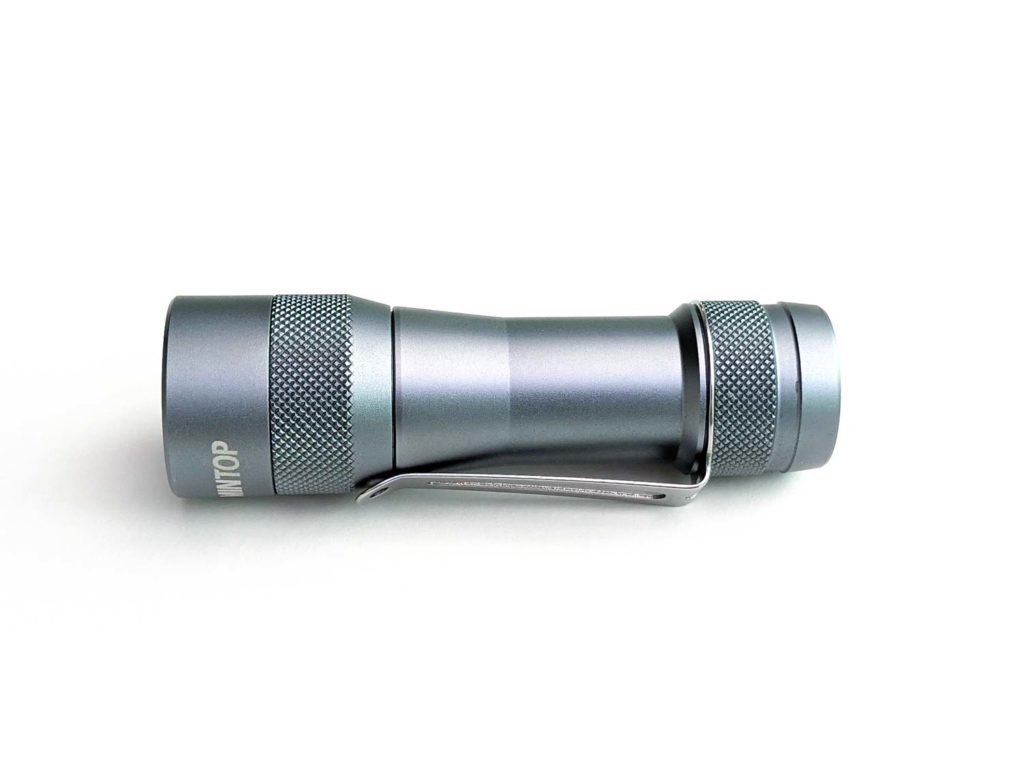
Lumintop FW4X specifications
| Brand/model | Lumintop FW4X |
|---|---|
| LED | 2 * CREE XP-L HI and 2 * Nichia 219C |
| Lumens | 3150 lm |
| Beam intensity | 15625 cd / 250m |
| Battery config. | 1*18650 |
| Material | Aluminum |
| Modes | 5 and variable colour temperature |
| Blinkies | N/A |
| Reflector | TIR |
| Waterproof | IPX8 |
| Review date | July 2021 |
Introduction:
We’ve reviewed 5 flashlights in the Lumintop FW series, from the high power Lumintop FW21 X9L to the very small Lumintop FWAA. There’s many variations, with different body materials, TIR/reflector options, and sizes. These all evolved from the FW3A, which was designed in collaboration with BLF and TLF members. The FW3A was a big success and since then Lumintop have reused the design in at least 20 other flashlights.
The FW4X is closest to the FW4A, taking an 18650 cell and having 4 LEDs behind a TIR optic. What’s special about the FW4X is the 2 pairs of LEDs that allow you to pick between warm white, cool white, or anything in between. The Sofirn LT1 lantern is known for doing this, using Anduril. Unlike most of the FW series, the FW uses its own special UI, instead of Anduril. The Sofirn IF25 (not IF25A) also has tint ramping and takes a single 21700.
So what’s the point in this, you might ask? You might want a variable CCT flashlight for photography. It can also be useful if you want a nice warm light for evening use indoors or while camping and cooler white for maximum brightness in emergencies. Chances are you don’t need tint ramping but it is quite cool and interesting to see how different light makes things look and to show people why your favourite colour temperature is best.
Package quality.
The 2-piece box the FW4A comes in is made of strong white cardboard and looks a bit nicer than their older packaging. Inside the box is black cut foam to keep everything safe.
The package comes with:
- Lumintop FW4X flashlight
- Manual
- Warning card, telling you to unscrew the head to insert the cell, not the tail
- 2 spare O-rings
- Gow diffuser cap
There’s no cell included, though some product listings include one. There’s also no lanyard included.
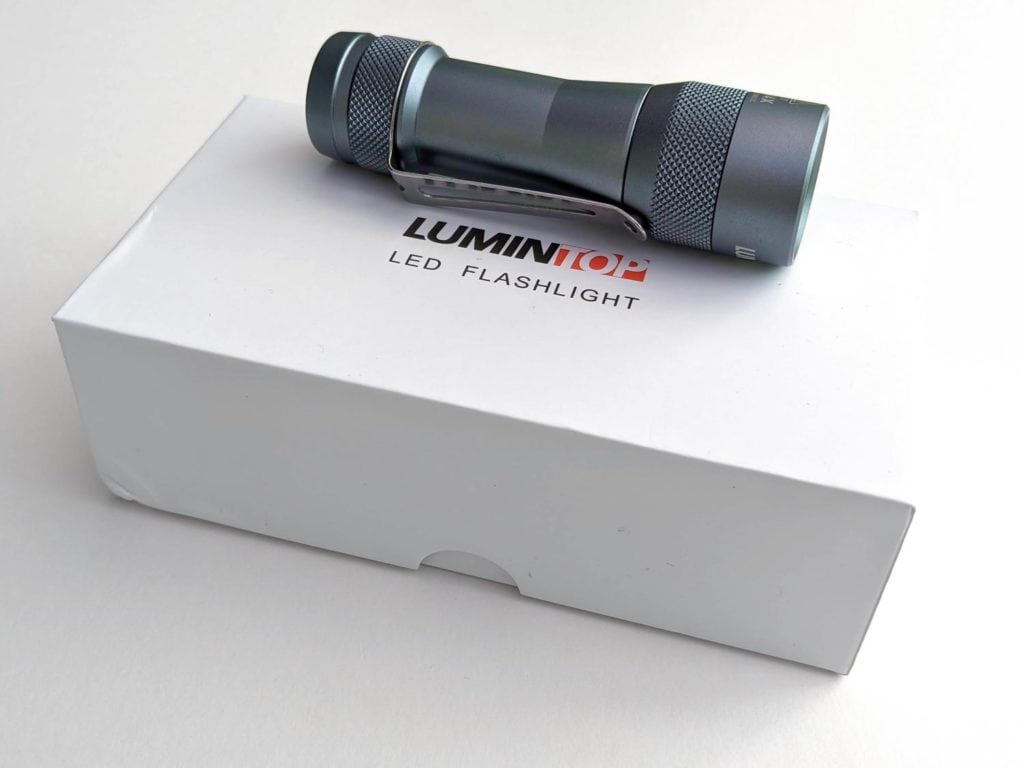
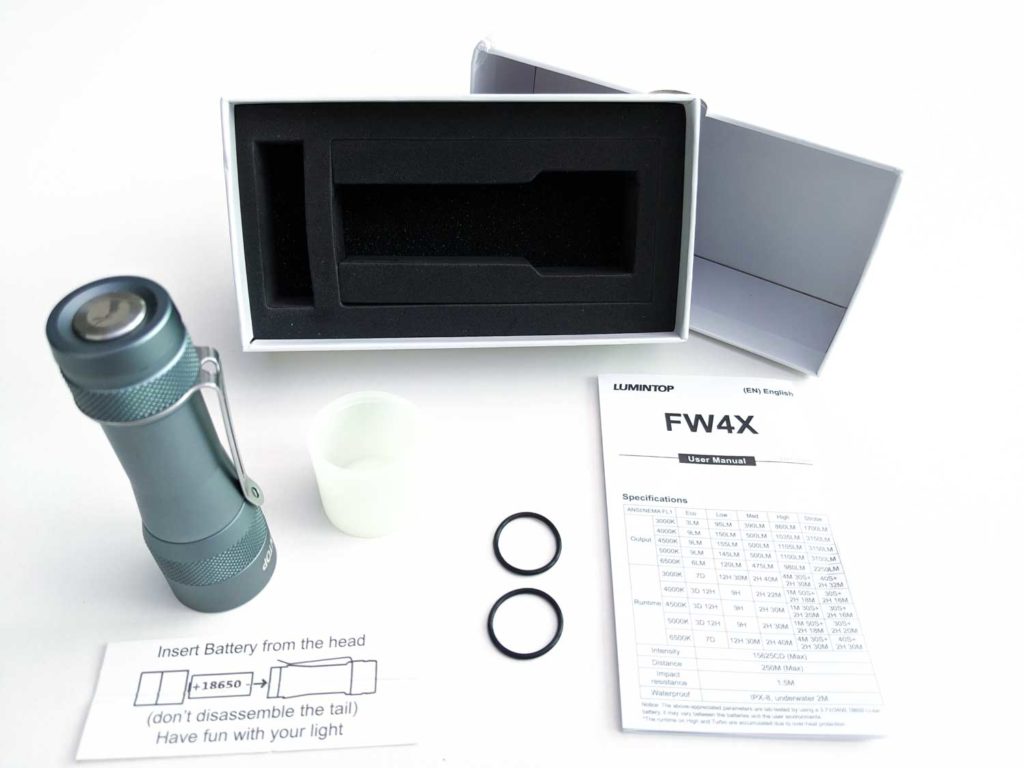
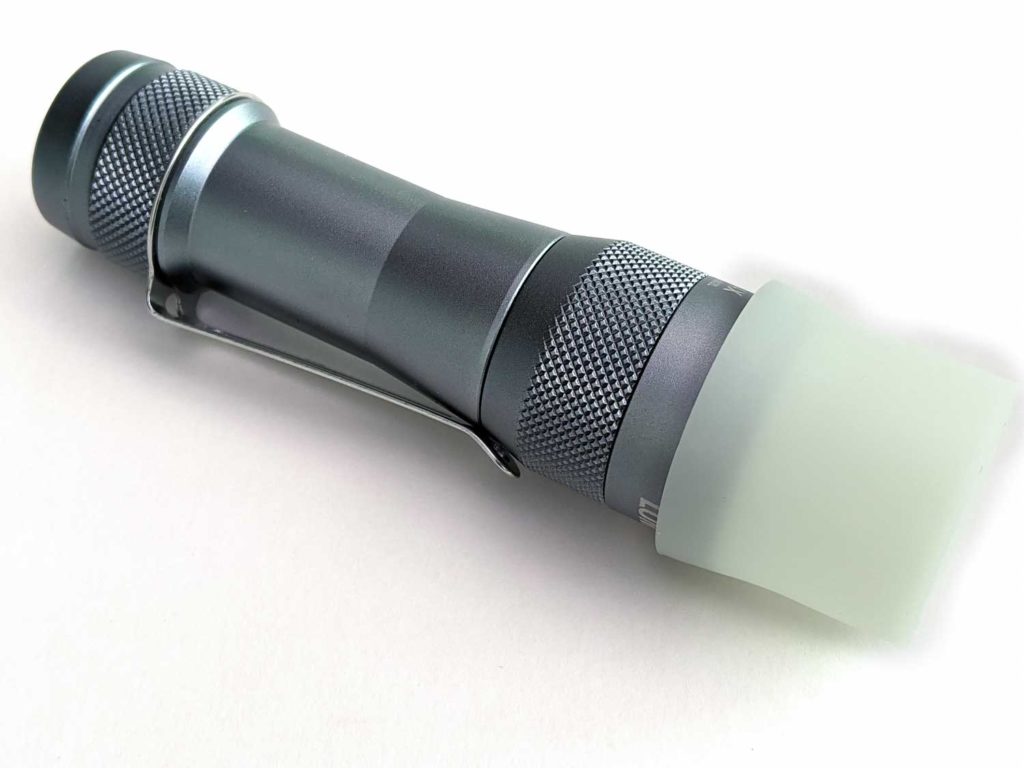
Flashlight in use
I have to admit that this is actually my first light in the FW series. It’s tiny for a 18650 cell flashlight! Even having 4 LEDs (like the FW4A) doesn’t make it much bigger. If you’re used to carrying 18650 flashlights then this one will easily fit in your pocket. The body tube is smooth but thanks to the clip and knurling on the head and tail it’s easy to grip.
All the FW lights, including the Lumintop FW4X have a rear clicky e-switch that sits flat, so the light will tail stand fine. Some people have had issues with FW switches in the past but this one seems great: easy to find and activate but not “mushy”.
The clip has a hole for a lanyard, though there’s not one included in the box. The is also the only thing stopping the FW4X from rolling.
The silicon glow diffuser came attached to the light so it fit in the box. It’s easy to put on but removing it is more of a challenge due to the air seal it makes on the perfectly round head. The diffuser is a handy addition as it makes the FW4X into a mini lantern.
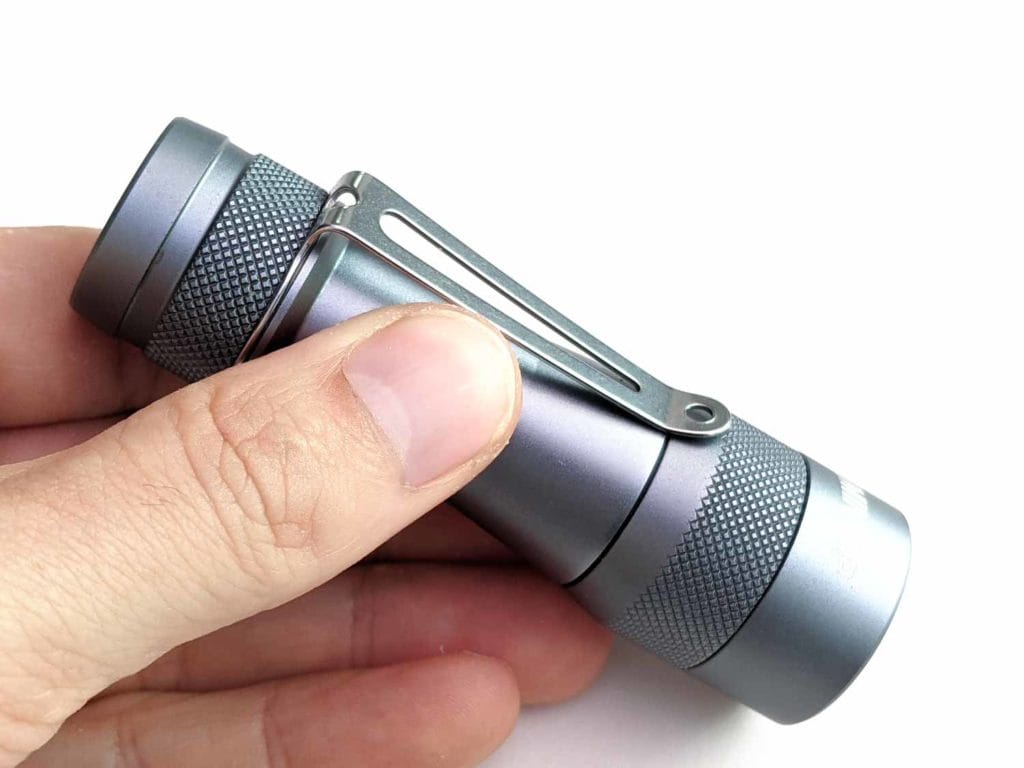
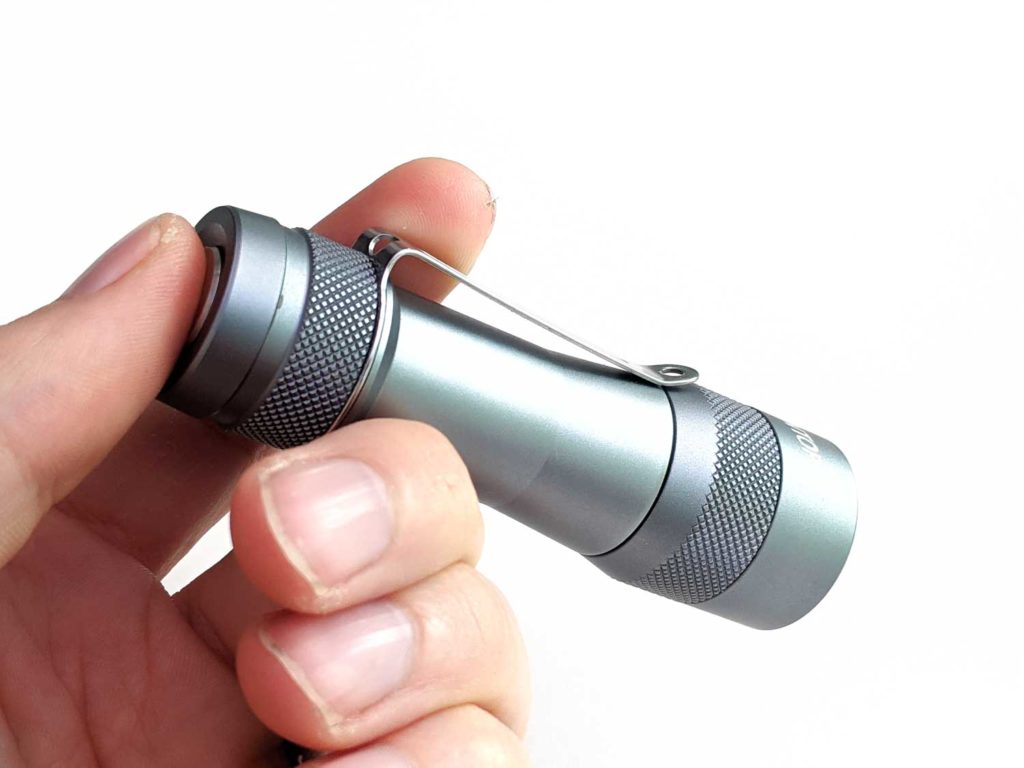
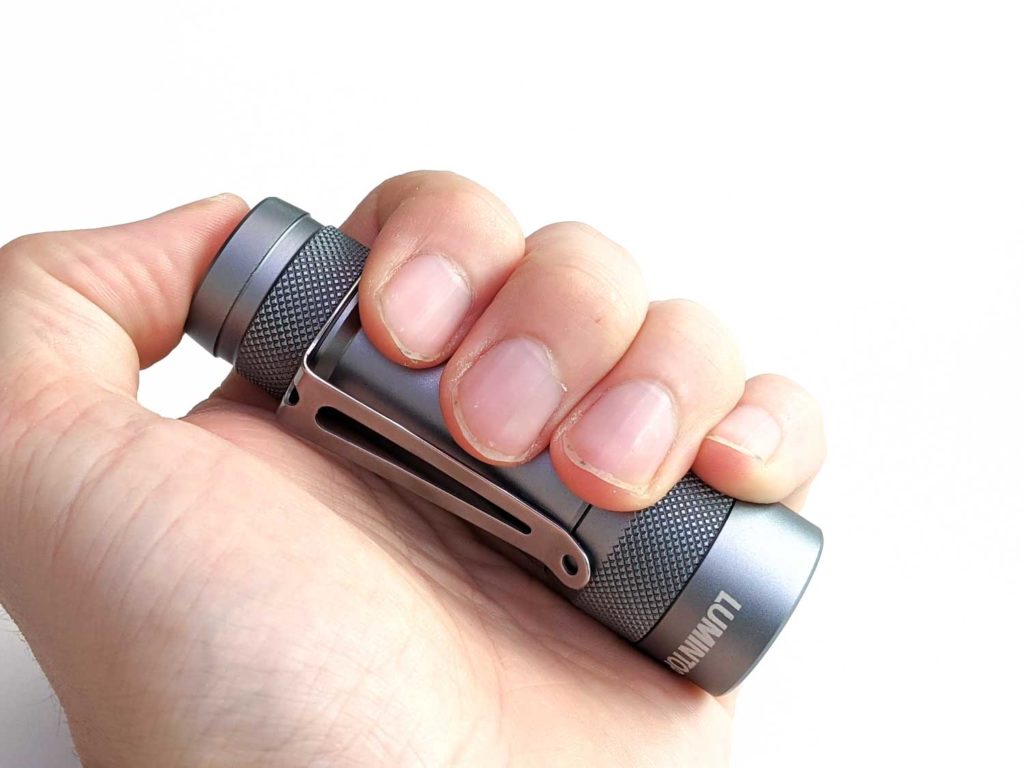
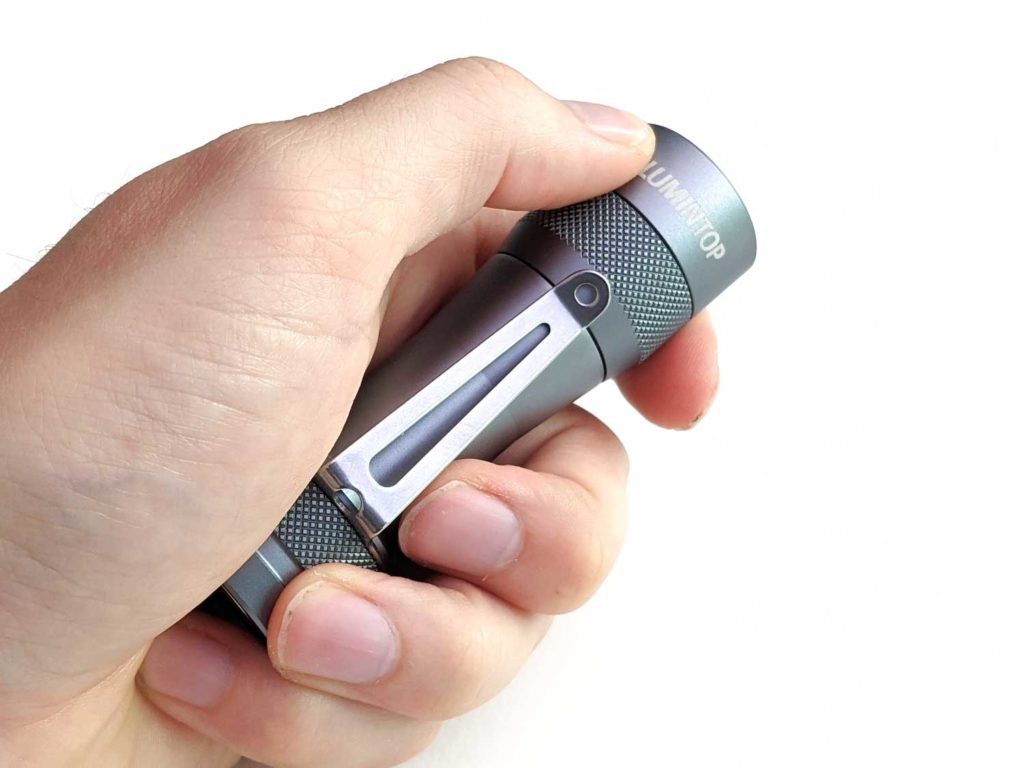
Build Quality, and Warranty
From the outside, the FW4A is lovely. I can see why Lumintop sells so many now. The light looks and feels well built and more like a premium brand than a budget or mid range one. The FW-style looks and light-grey colour also stands out against boring looking lights.
The grey aluminium is anodized with a slight matte effect. The anodising seems to be very well done. In fact the whole machining is great, with the diamond knurling being just right and all the edges having smooth bevels.
Unlike some other FW flashlights, Lumintop have printed their logo and model number on the FW4X, as well as the lights serial number and a warning about the heat.
Although the card in the box warned about unscrewing the tail cap, this is fine to do as long as you screw it back firmly before screwing the head back in. As with most other FW lights, the threads aren’t anodized and are conservatively lubed. O-rings are in all the right places, so I trust the IPX8 2m rating that Lumintop gives it.
The bezel unscrews too, so you can replace the LEDs or TIR optic if you want to mod the light.
The FW4X comes with Lumintop’s standard warranty. This gives you 30 days free replacement for defects and 5 years free repair for problems that develop from normal use. There’s also the lifetime warranty, where they charge for parts.
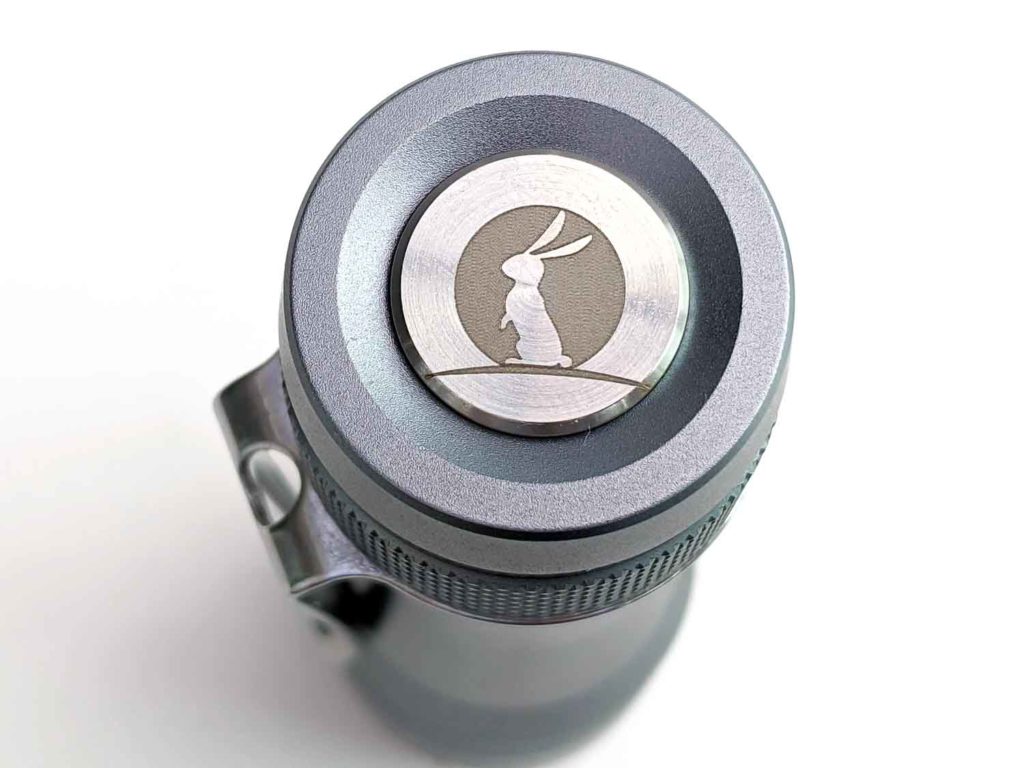
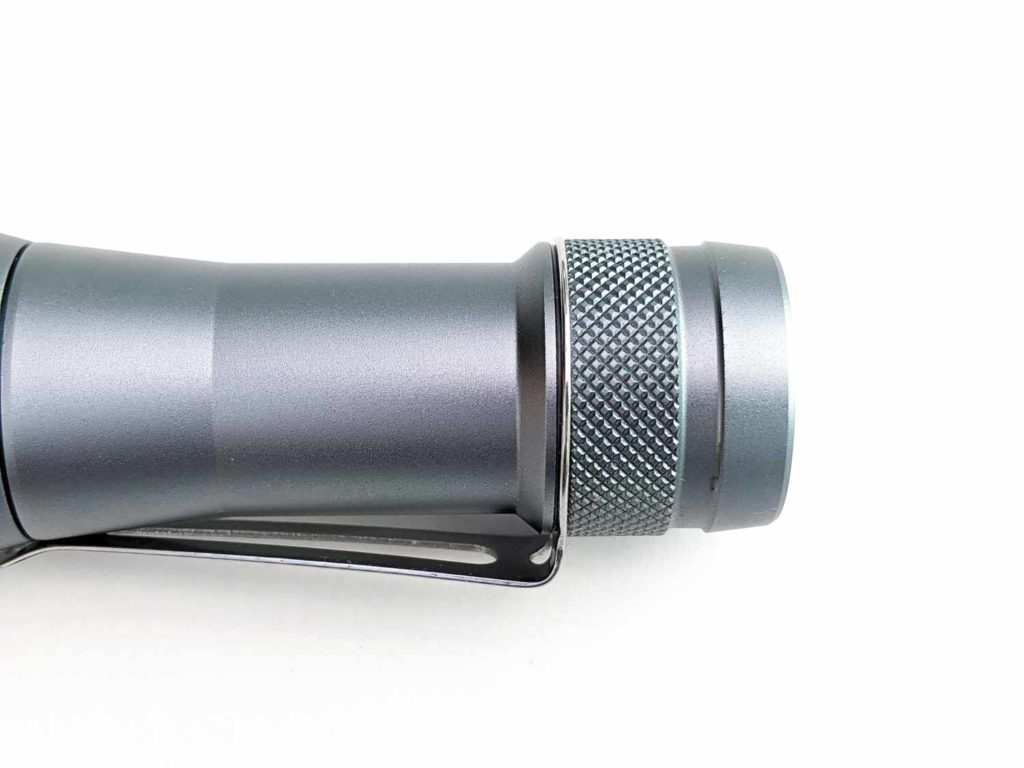

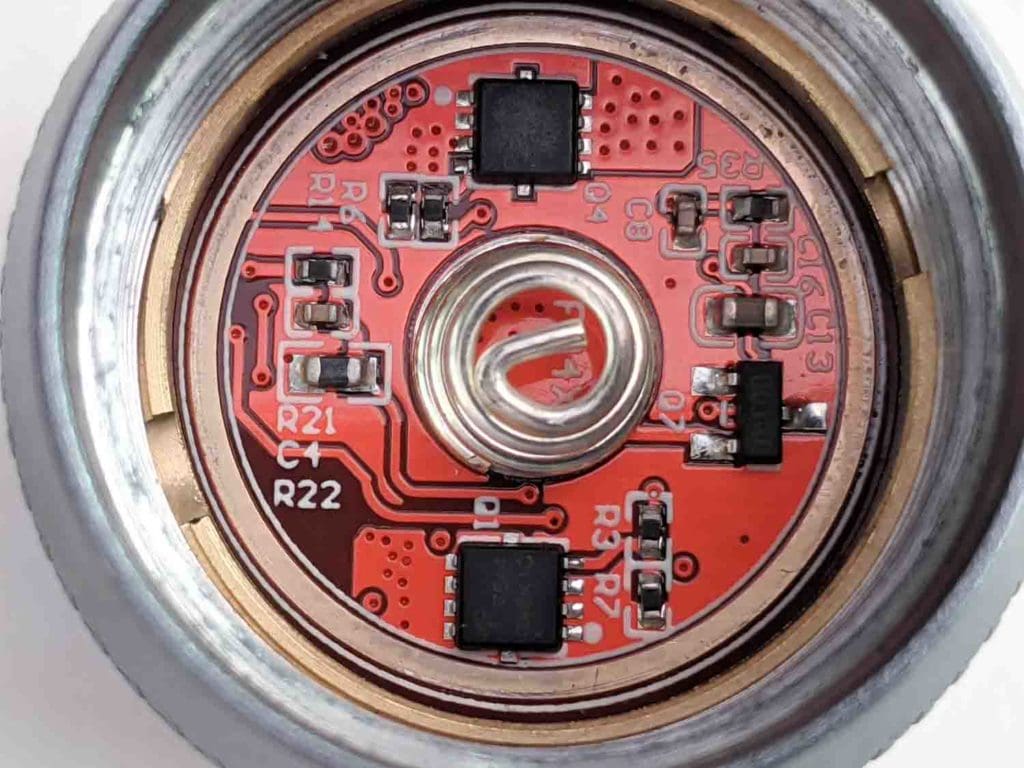
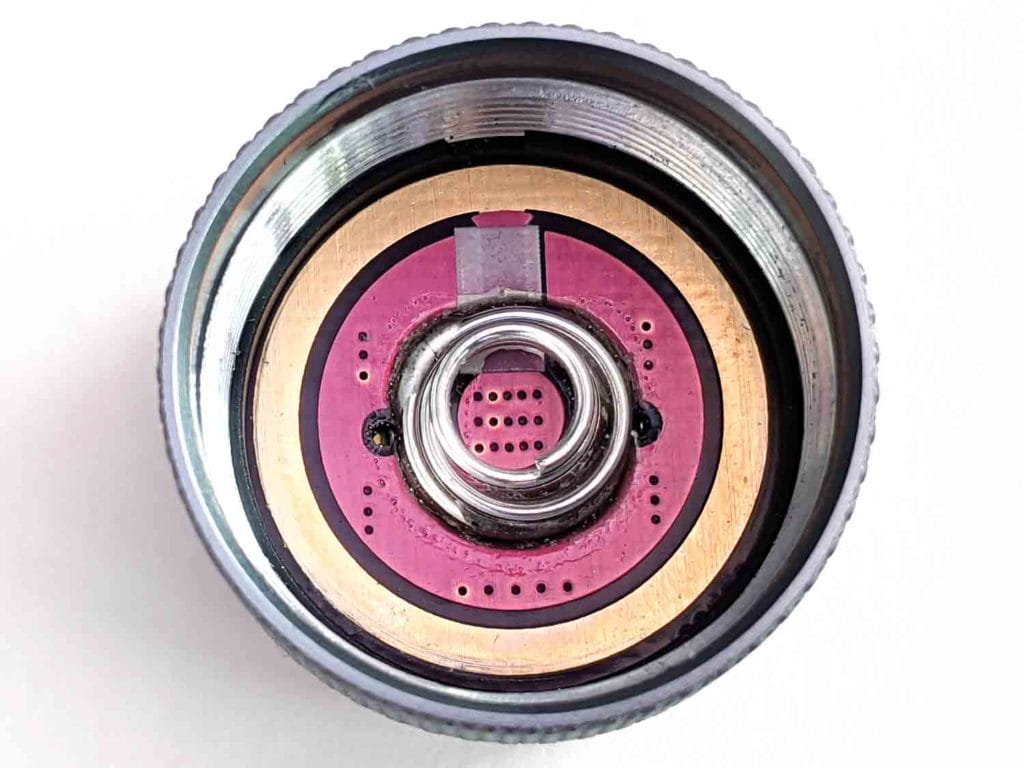
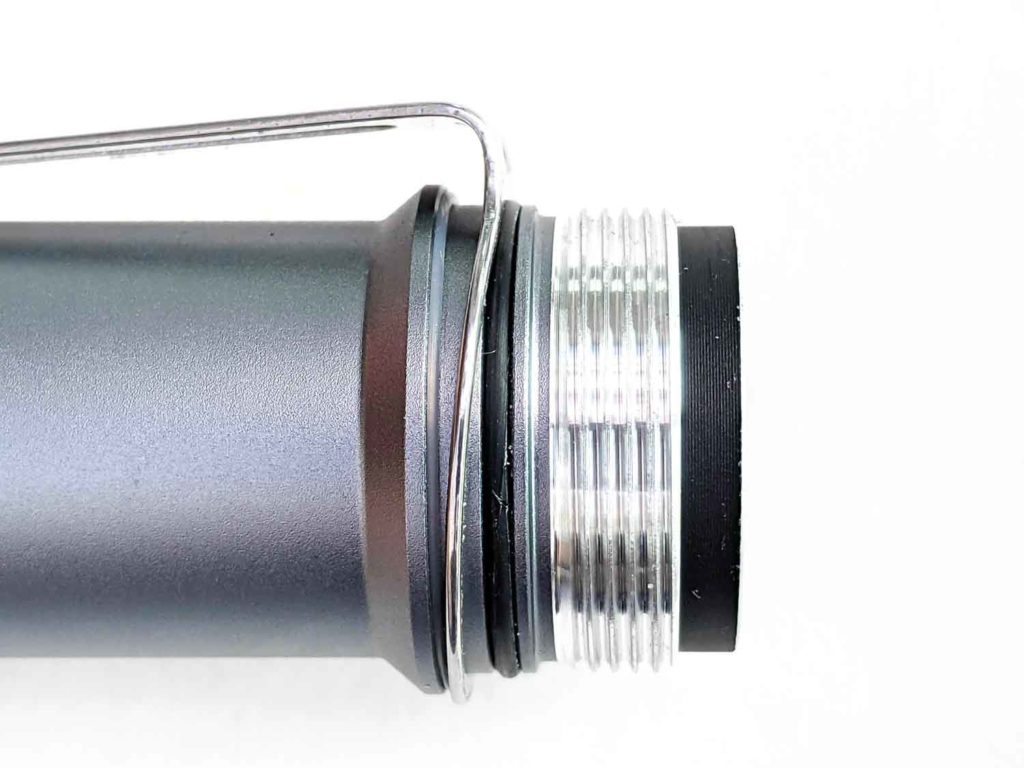
LED, Lens, Bezel, and Reflector
What sets the FW4X apart from all the others is the 2 pairs of LEDs and “variable tint” as Lumintop calls it. Technically it’s the correlated colour temperature (CCT ) that varies, not the tint. I won’t go into the details but tint is how a colour deviates from white (eg pink-ish or green-ish) and CCT is how warm or cool the white light looks.
There’s only one option here 2 * CREE XP-L HI and 2 * Nichia 219C. The CREEs are cool white (listed at 6500K) and the Nichias are warm white (3000K). The CRI isn’t listed but the Nichia is clearly moderately high and the CREE is fairly low. The UI lets you pick a colour temperature by setting the pairs at different relative brightness to each other. See below for how the UI works (spoiler: it’s no Anduril).
I was surprised that Lumintop went for XP-L HI and 219C, which will have slightly different beam profiles and forward voltages. Actually, though the beam is even thanks to the frosted optic and you can barely tell that it’s made from 2 different LEDs. Still, I would have picked 2 pairs of SST-20 LEDs. If you don’t like the LEDs, you could swap them for any 3535-sized LED.
Using all 4 LEDs gives you a neutral white light, with a slightly pink tint. To work out what colour you get when combining LEDs you draw a straight line between the 2 colours on a colour space chart and find the halfway point. If you’ve ever seen the black body line (BBL) on a colour space chart then you’ll know that the line is not straight between cool white and warm white. This results in light that is below the BBL.
The FW4X has a bezel that unscrews to reveal the glass lens. Under the lens is a TIR optic. This looks like a standard frosted Carlco optic but there’s no indication of which one is used.

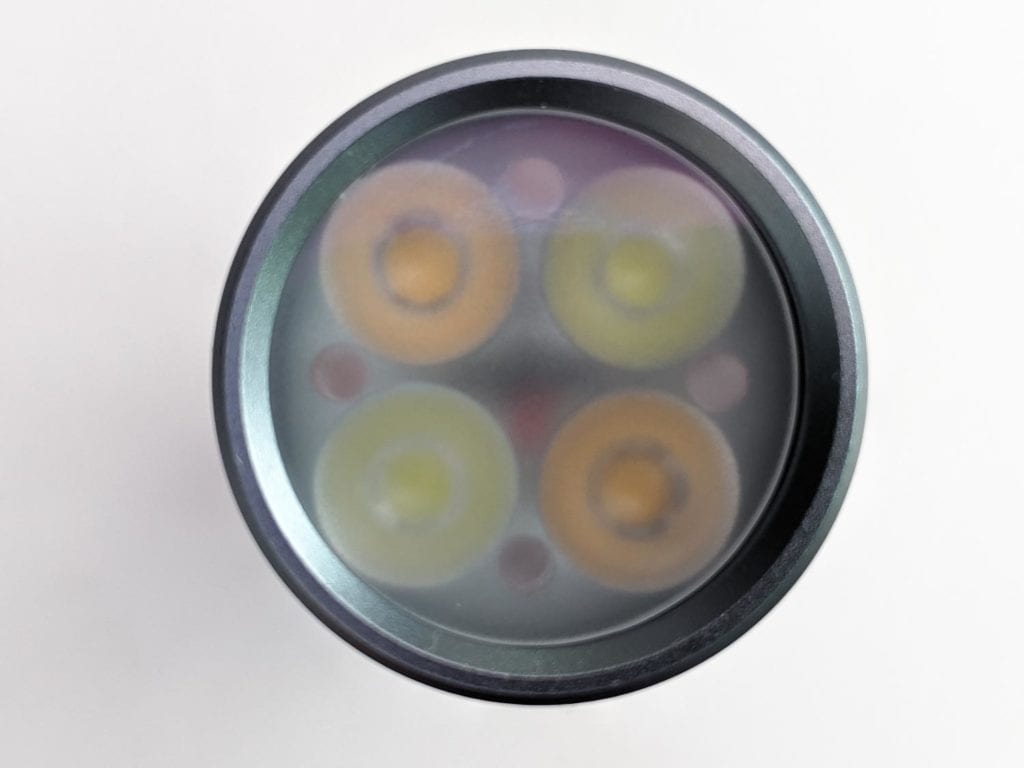
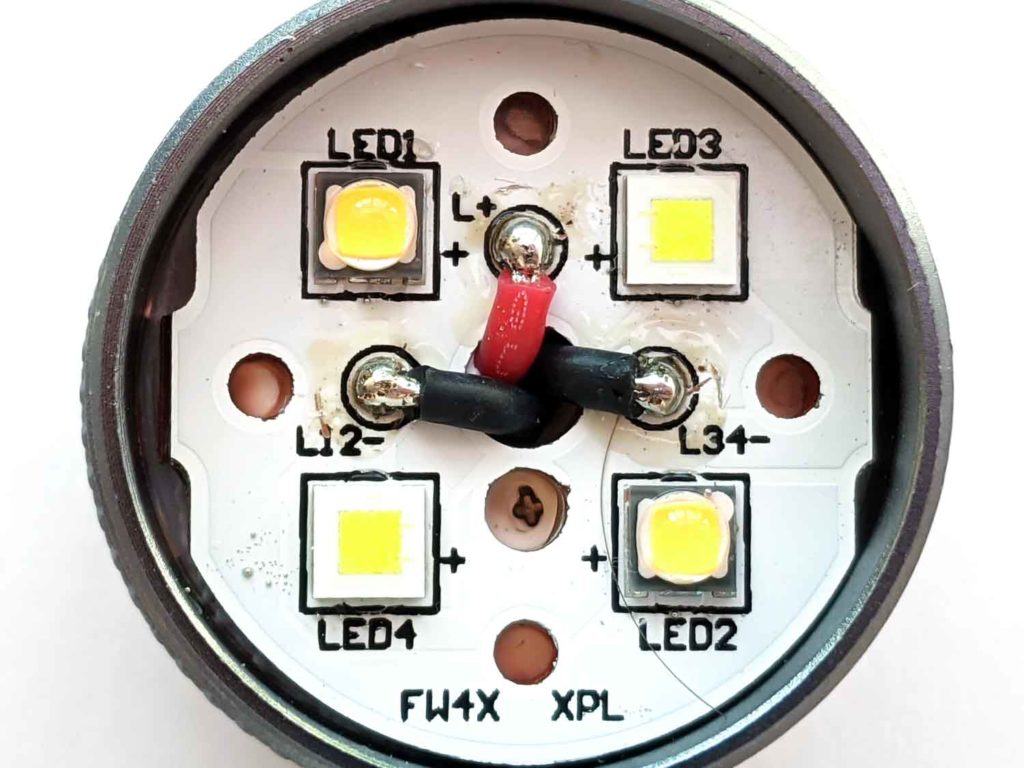
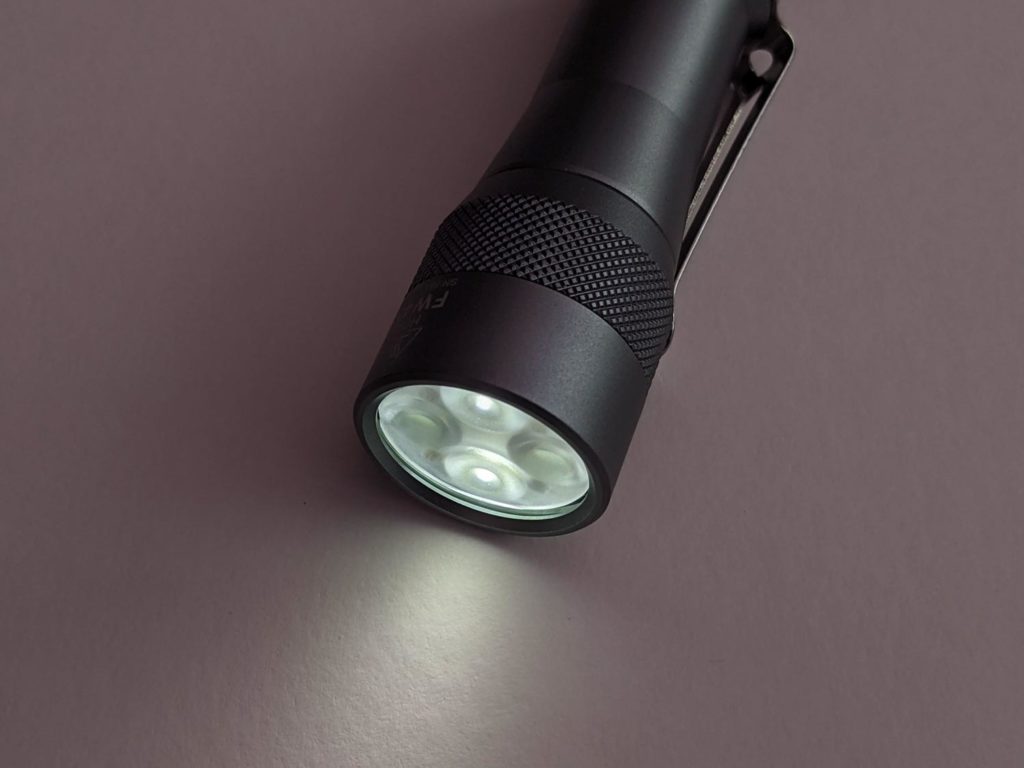
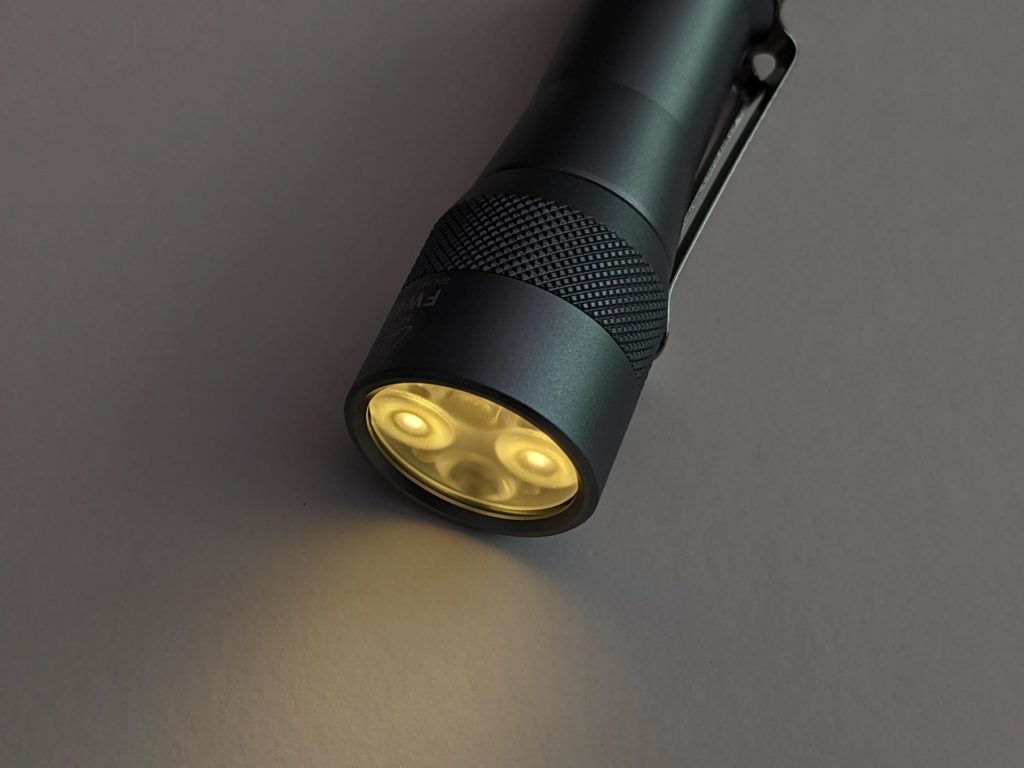
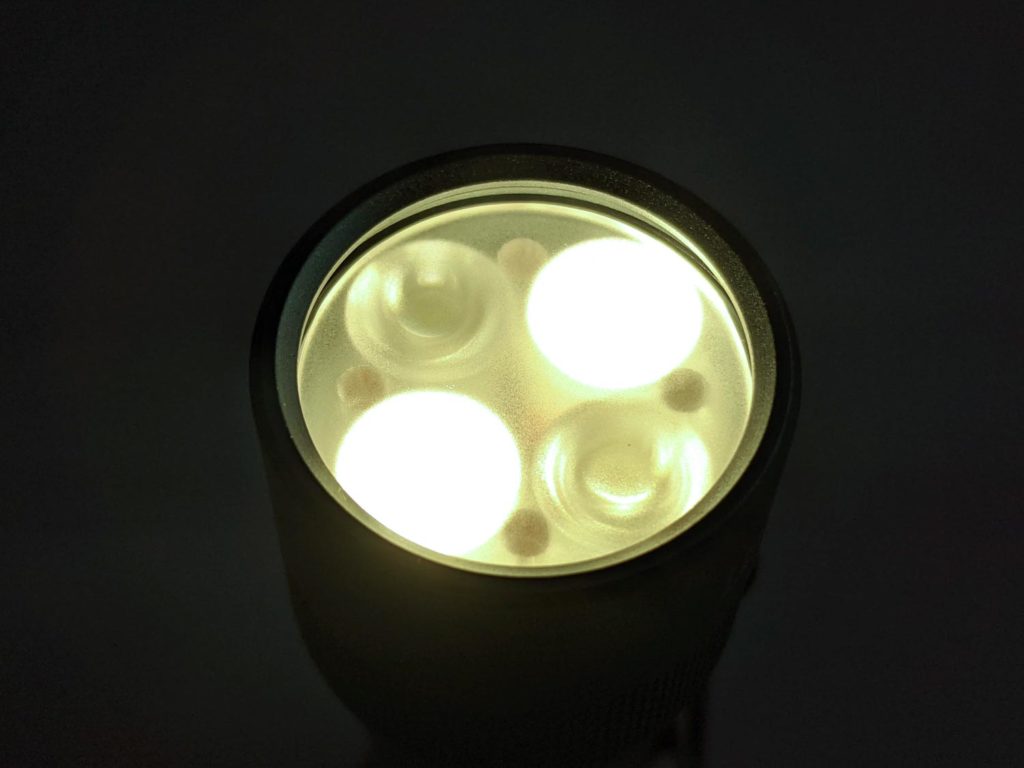
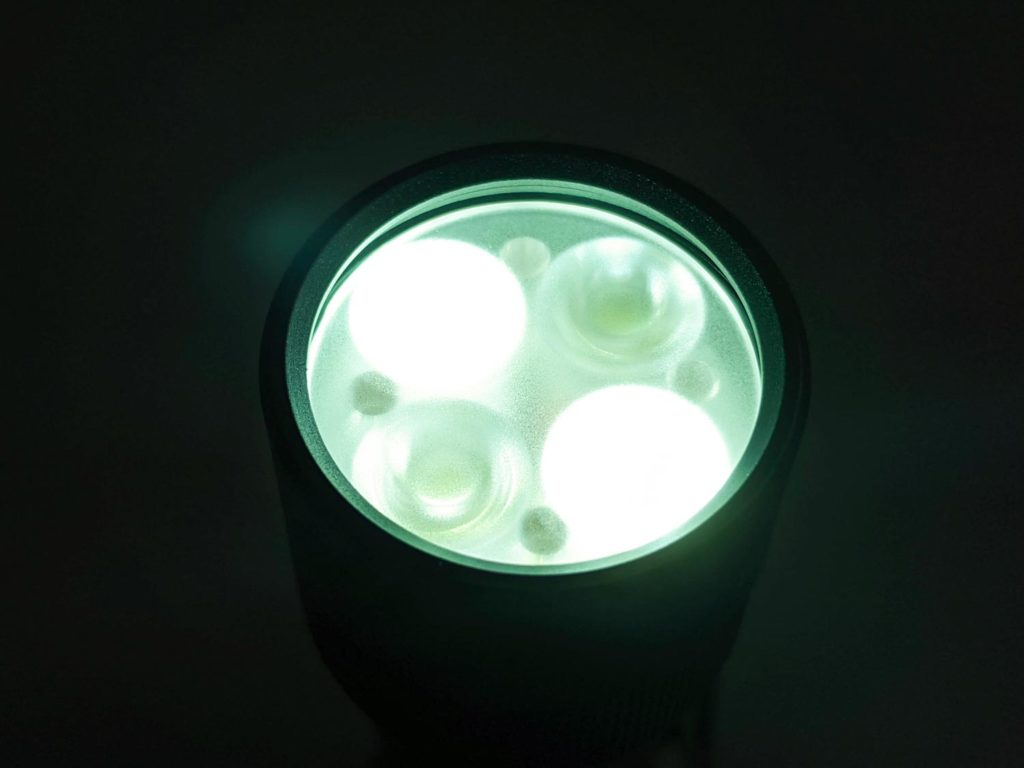
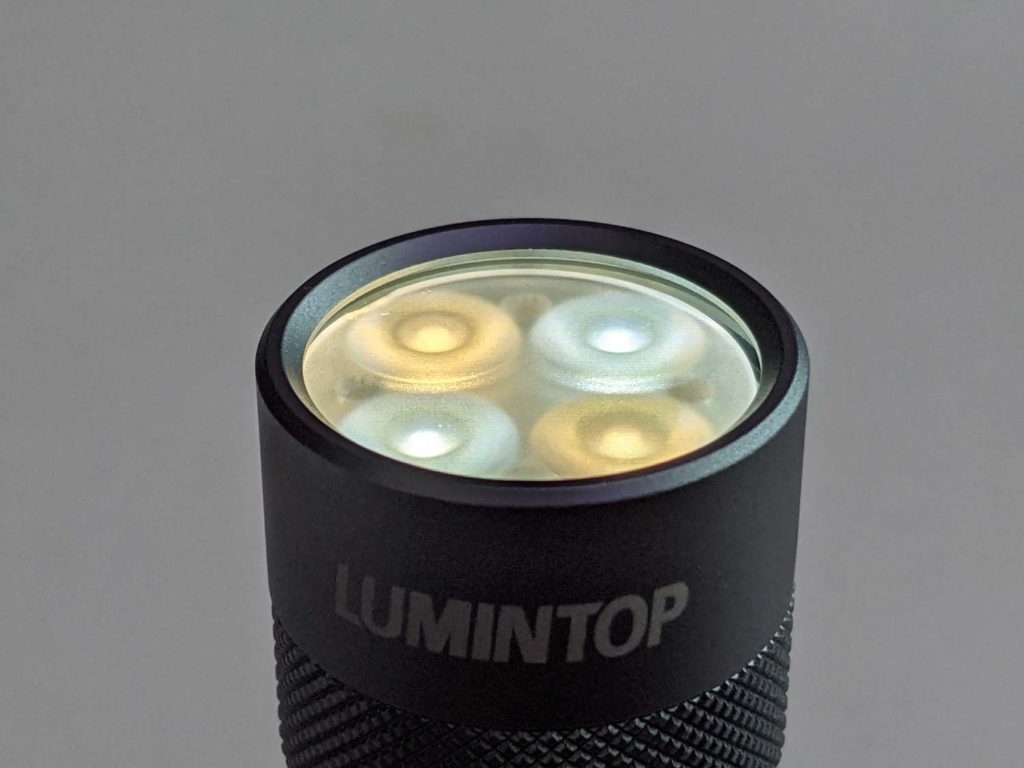
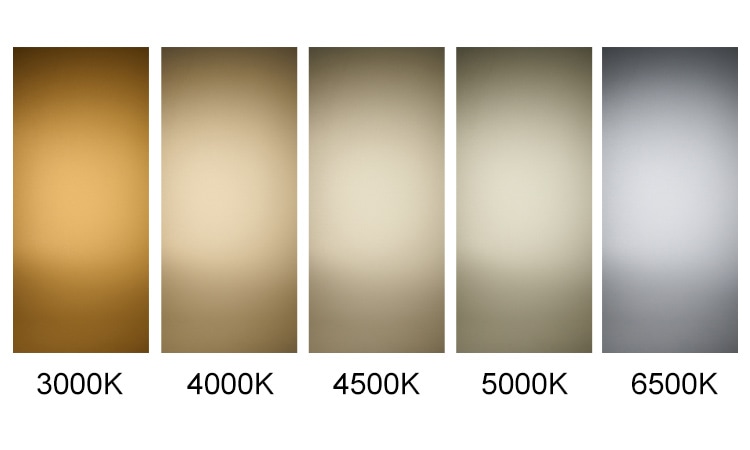
Dimensions and size comparison
- Length: 9.28 cm / 3.65 inches
- Head diameter: 2.84 cm / 1.12 inches
- Body diameter: 2.15 cm / 0.84 inches
Weight:
- With 18650 cell: 109g / 3.8 oz
- Without cell: 63g / 2.2 oz
EDC Flashlight size comparison
Compared to other EDC flashlights, from left to right.
- Lumintop Gift-G1
- Lumintop FW4X
- Lumintop D1
- Emisar D4V2

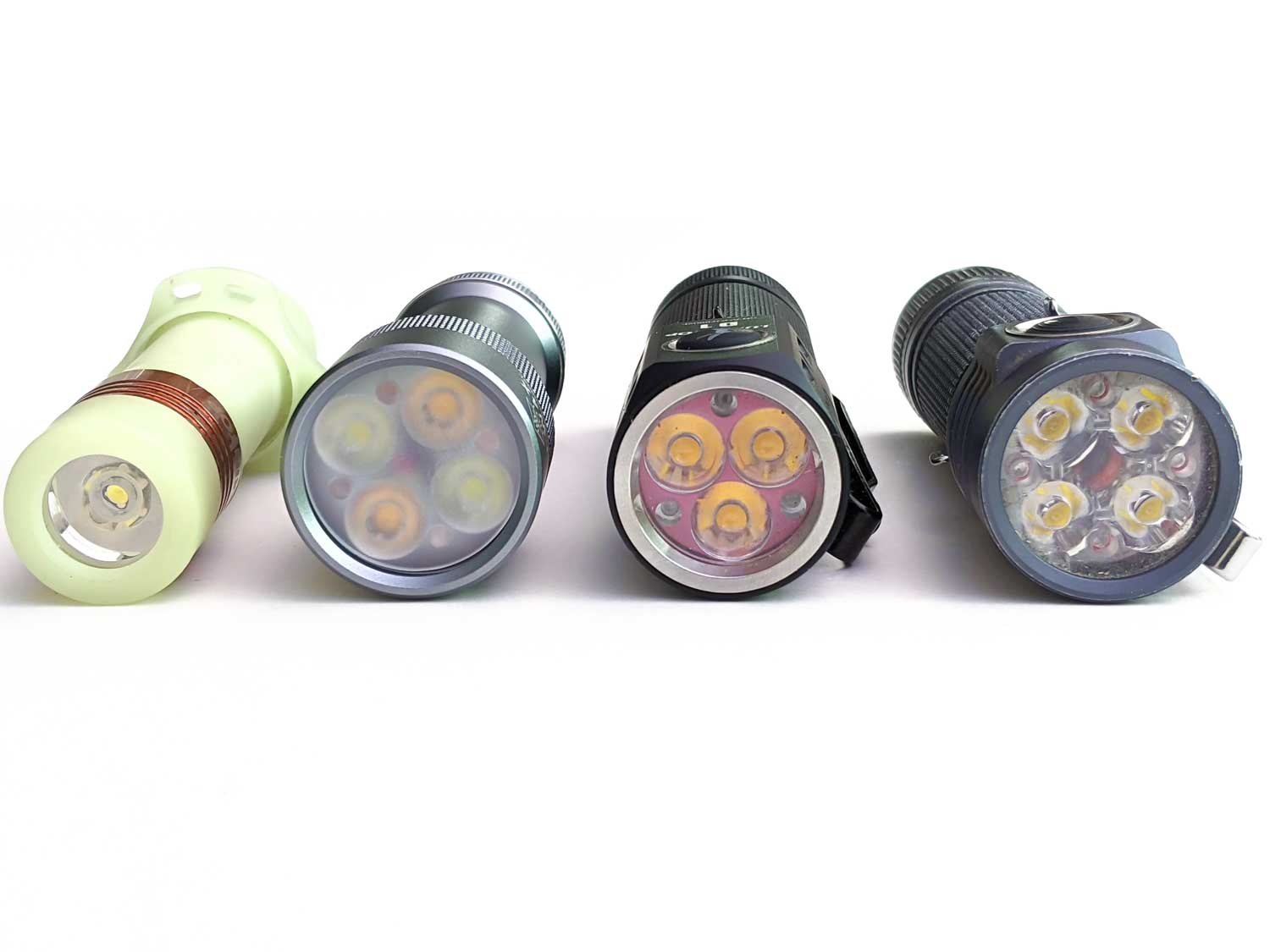
Driver & User Interface:
The FW4X is one of the few FW lights that doesn’t use the open source Anduril UI. Lumintop decided to use their own interface here, similar to their Lumintop D1, with hold for off. Hold for off isn’t my favourite but is simple to understand and get used to. Adding in tint ramping makes things a bit more complicated. The FW4X adds in the tint ramping as a separate config option that’s only available from off from a double click.
As an example, let’s say the flashlight is on warm white on high and you want to make it cooler. To do that you have to:
- hold (turn off)
- double click (enter tint config, which always uses low brightness)
- hold (select tint)
- double click (exit tint config)
- hold (turn back on)
Let’s see how you do the same with Anduril, like on the Sofirn LT1:
- double click and hold (select tint)
From on you can double click to go to turbo. From off, the same double click goes to tint config. Having such easy access to a config mode is a blessing and a curse. Tint config mode always starts off at 3000K on low, so in effect this means there’s a handy shortcut to low, though requiring a double click to turn off, instead of the usual hold. On one hand it’s very easy to change the colour temperature. On the other hand, it’s too easy to accidentally change the colour temperature, especially to 3000K.
The variable colour temperature is very effective. You can configure the CCT in either stepped increments or ramped. The stepped increments have named CCTs in the manual but I have no way to tell if they’re correct. Compared to other lights, the middle 3 look very similar and I would have guessed something more like 4600K, 4700K and 4800K. The first and last steps are quite big but you can always ramp instead. Weirdly you can ramp the CCT but you can’t ramp the brightness.
To be honest I found it a challenge to use when EDCing for a few days and taking measurements, accidentally switching to 3000K when I didn’t mean to. I can happily drive an automatic car or a manual (shift stick) car but not one that frequently varies between the two. Ideally, tint ramping would either be baked into the main UI (like Anduril) or it would be hidden away behind at least 4 clicks.
Another thing to watch out for with the UI: lockout isn’t really lockout. Instead it’s momentary low at the middle colour temperature. This is over 100 lumens, so not especially low. Not enough to burn a pocket but annoying if you accidentally activate it.
Modes: Eco, Low, Med, High, Turbo
From OFF:
- Click: on (mode memory for low, med and high)
- Hold: eco
- Double click: enter tint config mode
- Triple click: battery check
- 4 clicks: lock out
From ON:
- Click: change modes: low, med, high
- Hold: Off
- Double click: turbo
Mode memory:
- Yes
Low voltage warning:
- Yes, the flashlight blink at around 3.2V and drop down, then turn off
Strobe/blinkies
- None. Note that the manual mentions strobe but it means turbo
Lock-out mode:
- Yes
- 4 clicks to lock / unlock
- Hold: low (always 4500K)
Tint config mode:
- Click: cycle between 3000K, 4000K, 4500K, 5000K, 6500K
- Hold: ramp from 3000K to 6500K and back
PWM
- Noticeable with a camera but not by eye
Batteries & Charging
I’ll reiterate Lumintop’s warning here: insert battery from the head, don’t disassemble the tail. If you do unscrew the tail cap (hey, what are warnings for if not to be ignored), unscrew the head before screwing the tail back in and make sure the tail is screwed down tightly.
The light requires a 18650 cell. No cell came with my FW4X, though Lumintop can include one. A high drain cell is recommended, especially if you want to power all 4 LEDs on turbo. Lumintop suggests unprotected cells with a max length of 66mm. The flashlight is short, so longer cells won’t fit.
Performance
Lux meter: All lux and lumen measurements are from my home made integrating sphere, calibrated with a S2+ measured by Maukka. Measurements are done with a UNI-T UT383S lux meter and Adafruit TSL2591 connected to a Raspberry Pi (using RuTiTe by bmengineer). Expect them to be within +/-10%. Throw was measured indoors at 5m.
DMM: Current readings were taken with a Precision Gold PG10B DMM for low currents and a Mustool X1 clamp meter for high currents.
Cell: I used a high drain Sony VTC5A, charged to 4.18V each time. This is one of the highest drain cells but is only 2600mAh. You could get 15% longer runtimes with a 3000mAh cell like a Samsung 30Q. Lumintop measured runtimes with a 3400mAh cell.
Parasitic drain:
- 0.007mA – nothing to worry about
Runtime graph
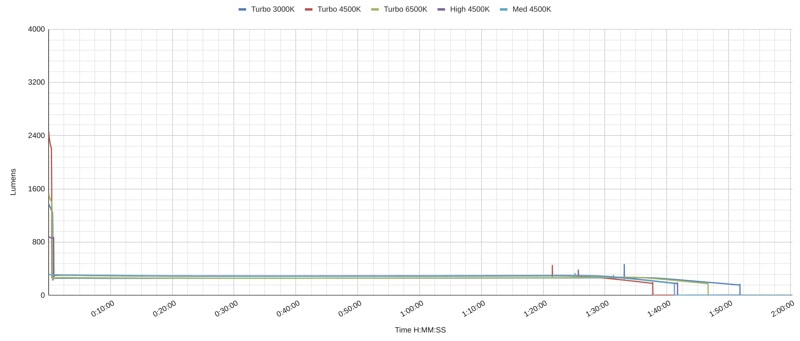
On the brightest tint (4500K), turbo starts off at 2459 lm but starts to drop just before 30 seconds down to the 300 lm medium level. Having just the cool CREE LEDs starts off at 1539 lumens and having just the Nichia LEDs starts at 1383. The high mode starts at 884 lm and while it sustains the output a little longer than on turbo, the light can’t sustain any more than about 300 lumens after just a minute.
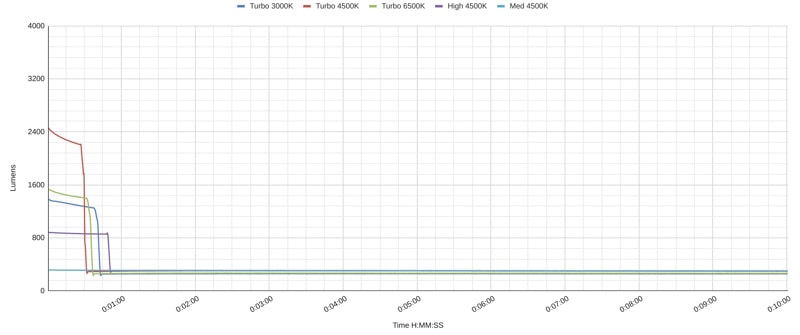
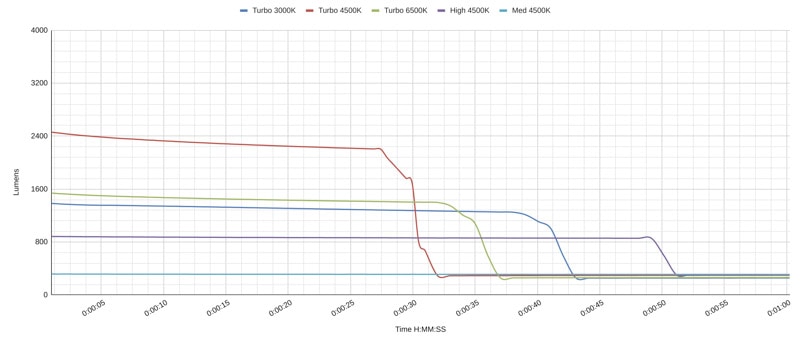
On turbo or high or medium, once it’s stepped down, the light sustains a steady 250-300 lm for a bit over an hour and a half. When the cell voltage is getting low it does a flash, then the output drops right down.
Lumen and current measurements (for each mode)
The FW4X has 5 colour temperatures and 5 modes. 25 in all, so I’m not going to measure every one. 4500K is the midpoint, so most of the measurements are from there. The current was a challenge to measure too, due to the e-switch sleeve.
4500K mode:
| Mode | Amps | Specs | 10min | 30 sec | start |
|---|---|---|---|---|---|
| Eco | 75 ma | 9 lm | 26 | 26 | 26 |
| Low | 0.60A | 155 lm | 119 | 119 | 119 |
| Med | 1.79A | 500 lm | 299 | 313 | 316 |
| High | 4.63A | 1105 lm | 301 | 863 | 884 |
| Turbo | 15.22A | 3150 lm | 296 | 1684 | 2459 |
Here’s low mode on different CCTs. The current and lumens vary here, due to many variables like the different LED forward voltage, LED efficiency, bias in my lux meter and how lumens are weighted to certain frequencies.
| CCT | Amps | Spec | start |
|---|---|---|---|
| 3000K | 0.44 | 95 lm | 63 lm |
| 4000K | 0.59 | 150 lm | 111 lm |
| 4500K | 0.6 | 155 lm | 119 lm |
| 5000K | 0.57 | 145 lm | 113 lm |
| 6500K | 0.48 | 120 lm | 88 lm |
Throw numbers (4500K mode):
The FW4X is specced at 250m (15,625 cd) on turbo.
| Mode | Throw distance | Candela |
|---|---|---|
| Low | 35m | 313 cd |
| Med | 60m | 898 cd |
| High | 97m | 2339 cd |
| Turbo | 136m | 4657 cd |
Beamshots
Photos were taken with a Pixel 3a, set to 1/2s shutter speed and ISO 400, F1.8. White balance was locked on cool white.
Distance to the bench is 6m, the tree on the right is 13m, the tree on the centre right is 18m and the building behind it is 69m.
This is with the FW4X set to the 5 different stepped modes. The middle 3 are almost identical outdoors but you can tell the difference against a white wall.
- Emisar D4V2 (4000K)
- Jetbeam EC26
- Lumintop D1 (3000K)
- Lumintop FW4X 3000K, 4000K, 4500K, 5000K, 6500K
- Lumintop Gift-G1 (4000K)
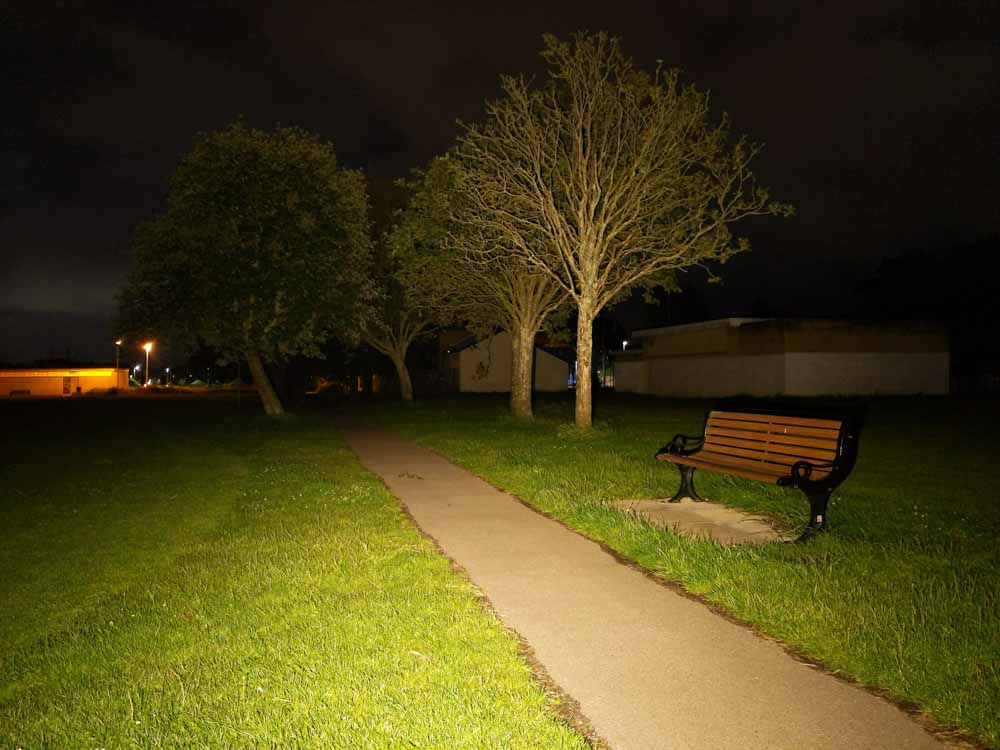

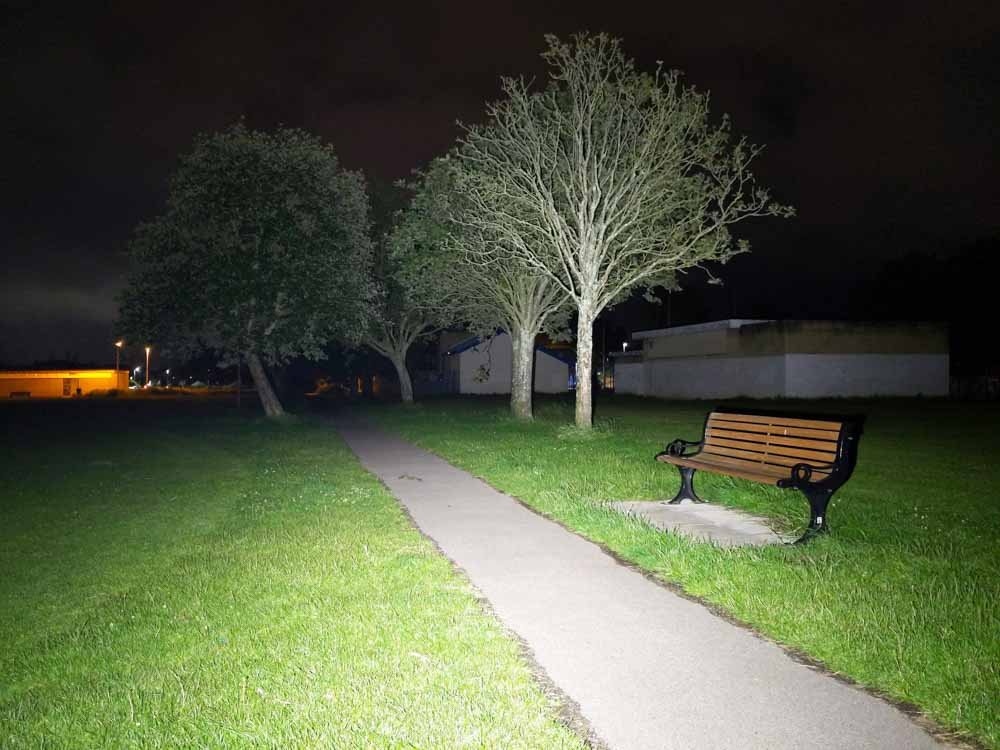
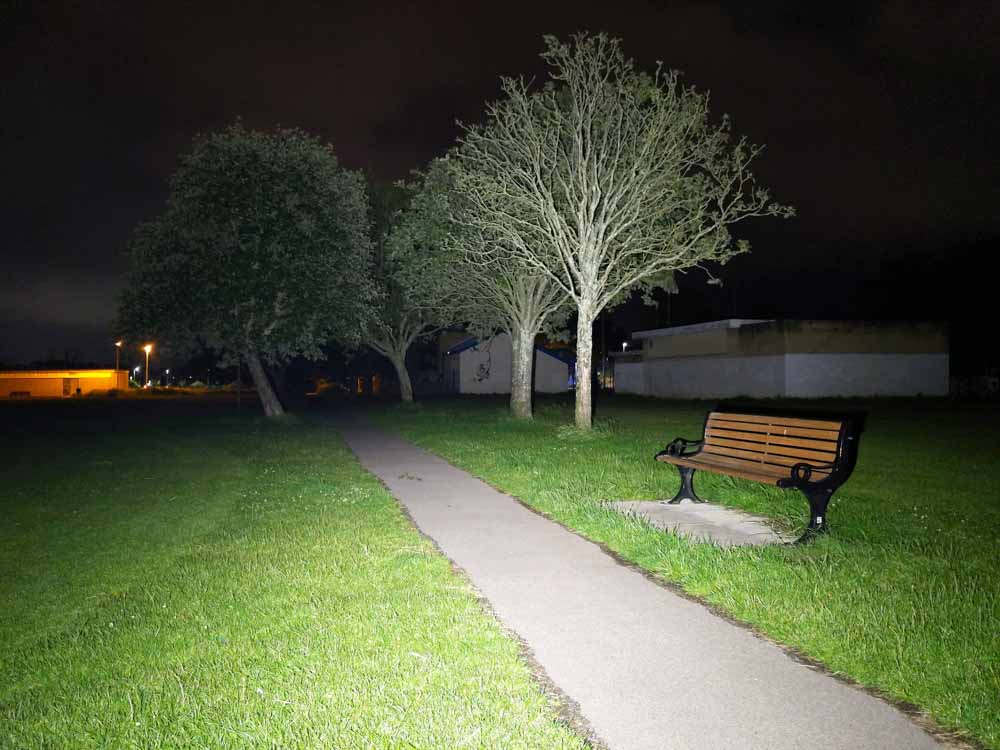
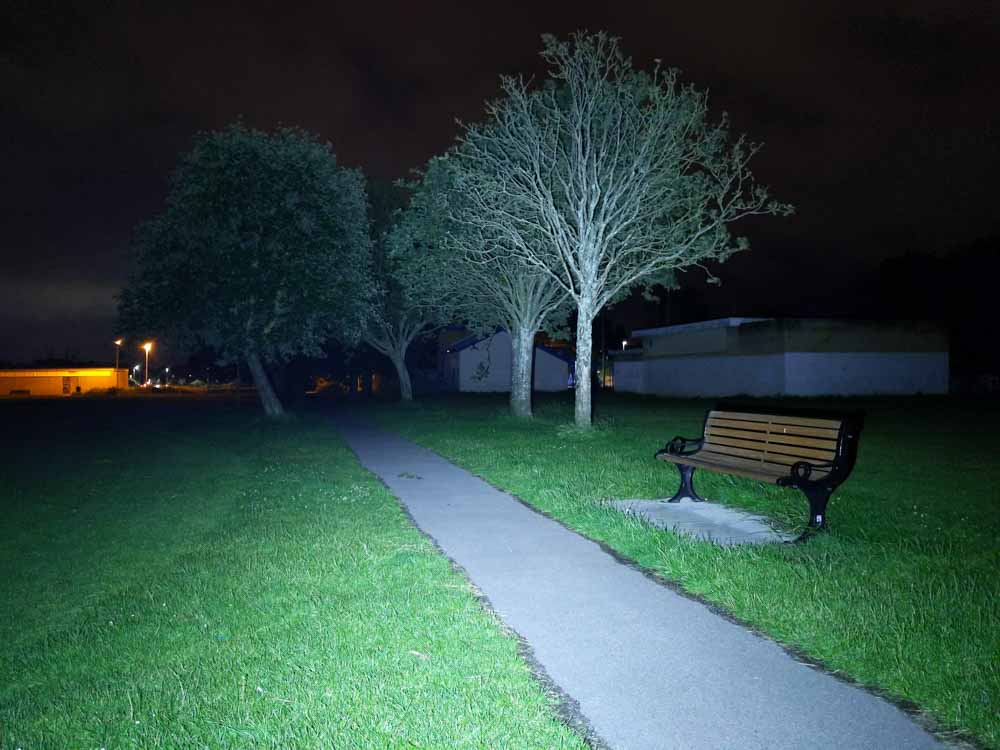
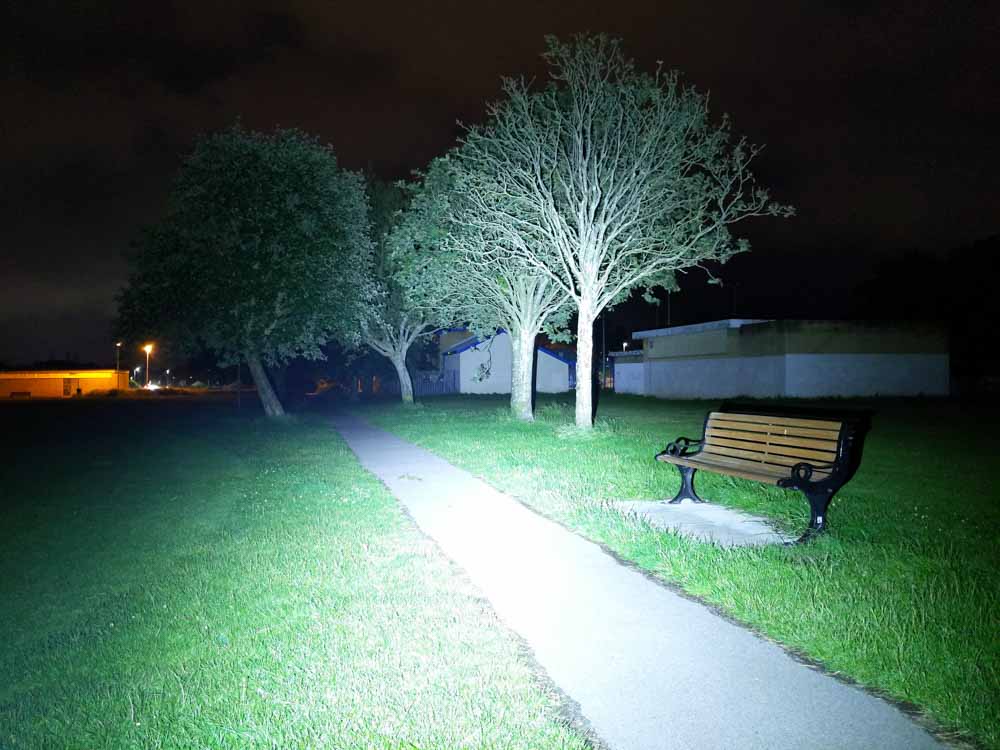
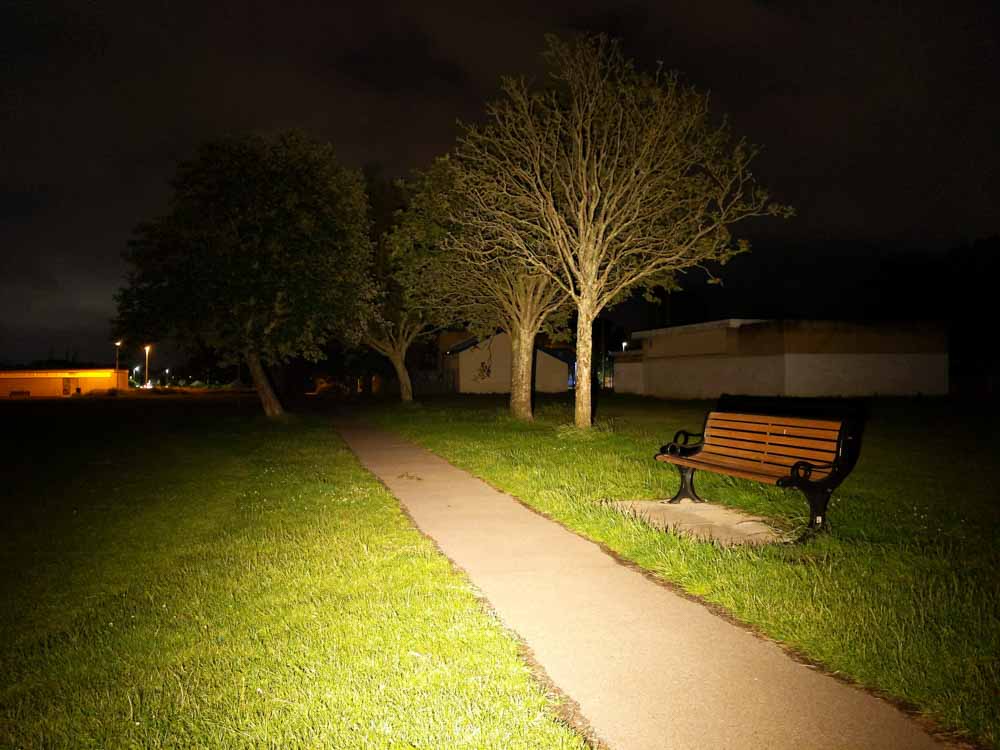
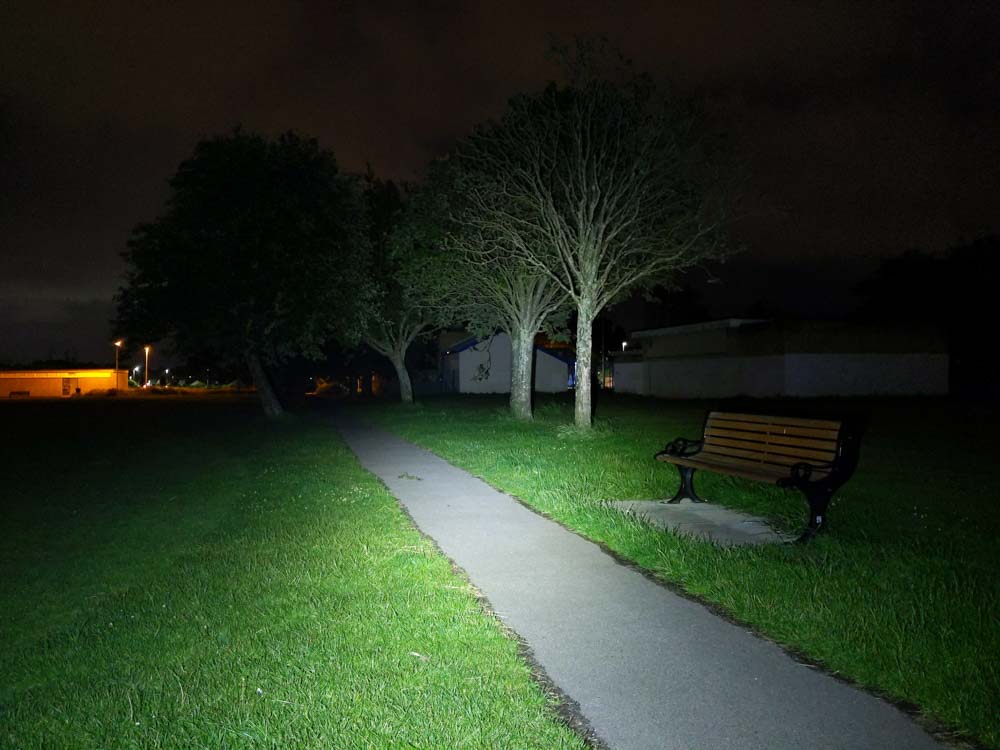
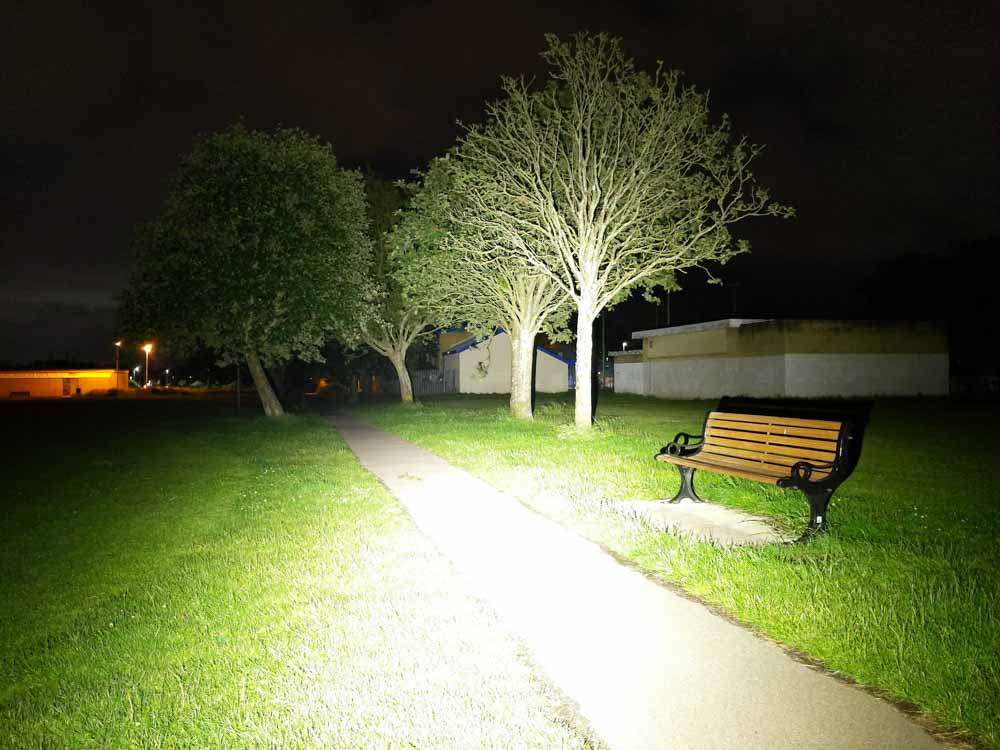
Disclaimer: This flashlight was sent to me for review at no cost by Nealsgadgets. I have not been paid to review, nor have I been holding back on problems or defects.
Final Verdict
Pros
- Variable colour temperature
- High quality host
- Small and light
- Switch button seems fine
- Good output on turbo
Cons
- To easy to reset the colour temperature
- Hold for off or double click for off, depending on mode
- Lockout mode is actually 100 lumens momentary
- Not reaching claimed beam intensity
- No moonlight
Explanation on star ratings:
1: Avoid: my phone flashlight would be a better choice – 2: Poor: significant defect or issues, much better options available at the same price – 3: Average: some defects or issues – 4: Good: recommended (minor issues) – 5: Great: highly recommended

3.5 stars: ★★★⋆
This is so close to an awesome light! I’d give it 4.5 stars if it weren’t for the UI. Sometimes I think I’m too picky about UIs but ultimately they’re what make a flashlight usable or not. In the case of the FW4X, unfortunately the UI makes it very awkward to use to its potential. Even without switching to Anduril then Lumintop could still make a few tweaks to make the UI more usable, like making double click always go to turbo instead of tint config, moving tint config to at least 3 clicks and making lockout only allow eco instead of the 100 lm low. I really hope Lumintop makes an updated UI for the FW4X. If not, hopefully the flashlight community will step in and get it running Anduril.
The UI aside, the general quality of the host is superb. Some FW flashlights have issues with the button but the switch this one is fine. That’s very fortunate, as a poor switch would make the UI even worse.
The mode spacing is reasonable too but I always like to have a moonlight mode (1 lumen at most) on an EDC light – 9 lumens is a bit much.
Being able to pick between 3000K and 6500K from a single flashlight is lots of fun. It would have been nice if Lumintop picked an even warmer CCT to give a wider range: 2000K to 6500K would have been great to see.
Overall, tint ramping is a handy feature to have and the general high quality of the light somewhat balances out issues with the weird UI. If you don’t mind switching to the wrong mode occasionally then this is a great light for playing with different colour temperatures.
Lumintop FW4x for sale
Get 15% off with our exclusive code: 1lumen711
1lumen selects and reviews products personally. We may earn affiliate commissions through our links, which help support our testing.